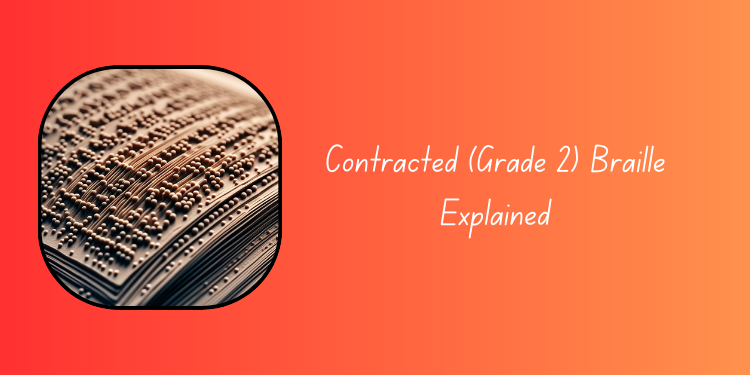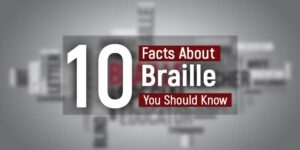Introduction
In the world of accessibility and inclusivity, Braille stands as a vital method to empower the visually impaired community. Within this landscape, two methods of braille exist: uncontracted or grade 1 braille and contracted or grade 2 braille. Contracted braille, sometimes referred to as Grade 2 braille, adds contractions and abbreviations to improve reading efficiency. In contrast, uncontracted braille provides a one-to-one correspondence between every letter of the alphabet.
If you want to know more about braille and are excited to learn more about any of these tactile methods of braille, then this blog is for you. In this blog post, we will be covering the intricacies of contracted braille by shedding light on its significance, applications, and impact.
What is Contracted Braille?

Contracted braille is the advanced form of braille. Individuals with little knowledge of braille cannot learn this method at first. For this reason, the method is termed a Grade 2 method of braille and is used mainly by experienced braille users.
Contracted braille is essentially a more complex type of tangible writing that uses a variety of contractions, acronyms, and shorthand versions of phrases and words. Condensed versions of common combinations of letters or words that pop up frequently are called contractions, and they are used to make braille materials smaller and easier to read.
For example, braille has specific contractions for words like THE, WILL, or FOR and frequently occurring combinations like ING, SH, or ER. It helps in faster readability and writing ability compared to uncontracted braille. Apart from this, contracted braille occupies low space.
Key components of contracted Braille
Various key components of contracted braille will merit attention, such as ;
Braille contractions: Braille contractions are the representation of common letter combinations like “ing” and, the, for. It allows blind readers to recognize a word more quickly.
Abbreviations: Similar to braille contractions, abbreviations shorten the braille characters by representing an entire word or phrase with a unique single symbol or combination of symbols.
Rules and exceptions: Though there are established conventions for contracted braille, there are also guidelines and exclusions that apply to the use of contractions. Proficiency in braille reading requires an understanding of these guidelines.
Who learns and applies contracted braille?
The process of learning contracted braille takes more time than its non contracted counterpart. However, a lot of people who are initially proficient in braille that is not contracted eventually move into the realm of contracted form, expanding their reading horizons.
The appeal lies in having access to the vast array of braille material, such as magazines and books, that are condensed to make it easier. Condensing content, contracted braille simplifies the braille experience by delivering smaller books. So regardless of initially being a learning process, the process from braille that was not contracted to will reveal a whole new world of literature that is a smaller, more manageable size.
Challenges and considerations
Although contracted braille has many advantages, mastering its complexities takes time, perseverance and a commitment to training. Anyone who is transitioning from uncontracted braille to contracted braille might initially encounter a difficult learning curve as they become familiar with new rules and contractions.
Moreover, the introduction of braille standards that are unified, which aim to harmonize braille codes across various languages and regions, brings both challenges and opportunities. While unified standards are designed to promote compatibility and consistency, however, they could also require changes and modifications for users who are used to regional conventions.
Conclusion
Lastly, contracted or grade 2 braille stands as the cornerstone of accessibility and advanced empowerment for visually impaired individuals. By incorporating abbreviations, contractions and shorthand representations, this method of braille can enhance reading efficiency, fostering literacy and promoting independence.
Amid our ongoing advocacy for inclusivity and accessibility, let us restate our dedication to advancing braille literacy programs, pushing for the inclusion of braille instruction in classrooms, and utilizing technology to increase the availability of braille resources. By working together, we can make sure that everyone who stands to gain from Braille’s profound impact experiences its transformative power. Want to continue your journey beyond the textual materials of braille? Explore the benefits of braille music notation through Braille music and more, dive deeper into the world of braille accessibility and discover the myriad opportunities awaiting exploration.
You Can Also Read Our Other Blogs
- Top 10 Fascinating Facts About Braille
- Breaking Down Barriers: Is Braille Hard to Learn?
- 4 Ways Learning Braille Can Be Fun and Games
- The Creativity in Braille: Art for the Visually Impaired
- The Importance of Braille in Today’s World
- The Impact of Braille Menus in Restaurants
- The History of Braille
- 12 Things You Probably Don’t Know About Braille







